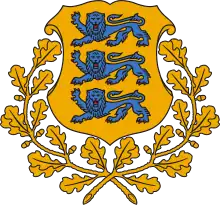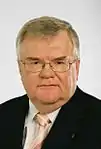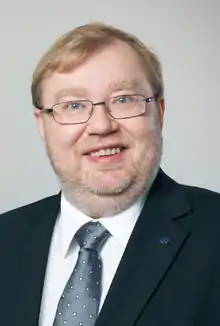2011 Estonian parliamentary election
A parliamentary election was held in Estonia on 6 March 2011, with e-voting between 24 February and 2 March 2011. The newly elected 101 members of the 12th Riigikogu assembled at Toompea Castle in Tallinn within ten days of the election. The incumbent government of the Reform Party and IRL continued in office until 2014 when Prime Minister Andrus Ansip resigned, ending his tenure as the longest-serving Prime Minister in contemporary Estonian history. He was replaced by Taavi Rõivas who formed a new coalition government with SDE. The Riigikogu elected after this election was the least fragmented in Estonian history, featuring only four parties.
| |||||||||||||||||||||||||||||||||||||||||||||||||||||||||||
101 seats in the Riigikogu 51 seats needed for a majority | |||||||||||||||||||||||||||||||||||||||||||||||||||||||||||
|---|---|---|---|---|---|---|---|---|---|---|---|---|---|---|---|---|---|---|---|---|---|---|---|---|---|---|---|---|---|---|---|---|---|---|---|---|---|---|---|---|---|---|---|---|---|---|---|---|---|---|---|---|---|---|---|---|---|---|---|
| Turnout | 63.53% | ||||||||||||||||||||||||||||||||||||||||||||||||||||||||||
| |||||||||||||||||||||||||||||||||||||||||||||||||||||||||||
 Results by electoral district | |||||||||||||||||||||||||||||||||||||||||||||||||||||||||||
| |||||||||||||||||||||||||||||||||||||||||||||||||||||||||||
The election was marked by the highest number of running independents (32) since 1992. Several independent candidates were members of the Estonian Patriotic Movement and many of them would later become known faces in the Conservative People's Party of Estonia (EKRE), including future leaders Mart Helme and Martin Helme.[1]
Electoral system
The 101 members of the Riigikogu (Parliament of Estonia) were elected using a form of proportional representation for a four-year term. The seats were allocated using a modified D'Hondt method. The country is divided into twelve multi-mandate electoral districts. There is a nationwide threshold of 5% for party lists, but if the number of votes cast for a candidate exceeds or equals the simple quota (which shall be obtained by dividing the number of valid votes cast in the electoral district by the number of mandates in the district) the candidate is elected.
Seats by electoral district
| The district number | Electoral District | Seats |
|---|---|---|
| 1 | Haabersti, Põhja-Tallinn and Kristiine districts in Tallinn | 9 |
| 2 | Kesklinn, Lasnamäe and Pirita districts in Tallinn | 11 |
| 3 | Mustamäe and Nõmme districts in Tallinn | 8 |
| 4 | Harjumaa (without Tallinn) and Raplamaa counties | 14 |
| 5 | Hiiumaa, Läänemaa and Saaremaa counties | 6 |
| 6 | Lääne-Virumaa county | 5 |
| 7 | Ida-Virumaa county | 8 |
| 8 | Järvamaa and Viljandimaa counties | 8 |
| 9 | Jõgevamaa and Tartumaa counties (without Tartu) | 7 |
| 10 | Tartu city | 8 |
| 11 | Võrumaa, Valgamaa and Põlvamaa counties | 9 |
| 12 | Pärnumaa county | 8 |
Opinion polls
Pre-election polls put the Reform Party, led by Prime Minister Andrus Ansip, ahead of its main rival, the opposition Centre Party. The former is right of centre, the latter is considered populist, slightly to the left on economic matters. Both parties are members of the European Liberal Democrat and Reform Party. Reform was slightly more socially liberal in comparison to Centre, while SDE was the most liberal out of the parties. IRL, meanwhile, was socially conservative, together with Centre. However, most parties had ruled out cooperation with Centre after its leader's controversial comments on regarding the Bronze Night riots and history of scandals.
| Date | Polling firm | Ref | Kesk | IRL | SDE | Greens | ERL | Others | Lead | Ansip's cabinet – Opposition |
|---|---|---|---|---|---|---|---|---|---|---|
| 6 Mar 11 | Election Results | 28.6 | 23.3 | 20.5 | 17.1 | 3.8 | 2.1 | 4.6 | 5.3 | 49.1 - 50.9 |
| 25 Feb 11 | TNS Emor | 28 | 25 | 21 | 16 | 4 | 2 | — | 3 | 49 - 47 |
| Jan 11 | Turu-Uuringute | 25 | 19 | 12 | 9 | 2 | 2 | 9 | 6 | 37 - 41 |
| Jan 11 | TNS Emor | 36 | 23 | 16 | 14 | 4 | 2 | — | 13 | 52 - 43 |
| Dec 10 | TNS Emor | 36 | 23 | 15 | 13 | 5 | 4 | — | 13 | 51 - 45 |
| Nov 10 | TNS Emor | 43 | 23 | 15 | 11 | 3 | 2 | — | 20 | 58 - 39 |
Contesting parties
The Estonian National Electoral Committee announced that nine political parties and 32 individual candidates registered to take part in the 2011 parliamentary election. Their registration numbers and order were determined by a draw lot.
| # | Name | Ideology | Political position | Leader | Total candidates | 2007 result | ||
|---|---|---|---|---|---|---|---|---|
| Votes (%) | Seats | |||||||
1 |
Greens | Green politics | Centre-left | Aleksei Lotman | 122 | 7.1% | 6 / 101 | |
2 |
IRL | Liberal conservatism | Centre-right | Mart Laar | 125 | 17.9% | 19 / 101 | |
3 |
Social Democratic Party | Social democracy | Centre-left | Sven Mikser | 125 | 10.6% | 10 / 101 | |
4 |
Reform Party | Classical liberalism | Centre-right | Andrus Ansip | 125 | 27.8% | 31 / 101 | |
5 |
Centre Party | Plurinationalism | Centre-left | Edgar Savisaar | 125 | 26.1% | 29 / 101 | |
6 |
Russian Party | Russian minority interests | Syncretic | Stanislav Tšerepanov | 16 | 0.2% | 0 / 101 | |
7 |
Independence Party | Estonian nationalism | Far-right | Vello Leito | 16 | 0.2% | 0 / 101 | |
8 |
People's Union[lower-alpha 1] | Agrarianism | Centre to centre-left | Andrus Blok | 88 | 7.1% | 6 / 101 | |
9 |
Christian Democrats | Christian democracy | Centre-right | Peeter Võsu | 15 | 1.7% | 0 / 101 | |
— |
Individual candidates | — | 32 | did not exist | ||||
Conduct
 |
|---|
The Office for Democratic Institutions and Human Rights of the Organization for Security and Co-operation in Europe observed this election and issued a report with a number of recommendations.[3]
Results
 | |||||
|---|---|---|---|---|---|
| Party | Votes | % | Seats | +/– | |
| Estonian Reform Party | 164,255 | 28.56 | 33 | +2 | |
| Estonian Centre Party | 134,124 | 23.32 | 26 | –3 | |
| Pro Patria and Res Publica Union | 118,023 | 20.52 | 23 | +4 | |
| Social Democratic Party | 98,307 | 17.09 | 19 | +9 | |
| Estonian Greens | 21,824 | 3.79 | 0 | –6 | |
| People's Union of Estonia | 12,184 | 2.12 | 0 | –6 | |
| Russian Party in Estonia | 5,029 | 0.87 | 0 | 0 | |
| Party of Estonian Christian Democrats | 2,934 | 0.51 | 0 | 0 | |
| Estonian Independence Party | 2,571 | 0.45 | 0 | 0 | |
| Independents | 15,882 | 2.76 | 0 | 0 | |
| Total | 575,133 | 100.00 | 101 | 0 | |
| Valid votes | 575,133 | 99.12 | |||
| Invalid/blank votes | 5,131 | 0.88 | |||
| Total votes | 580,264 | 100.00 | |||
| Registered voters/turnout | 913,346 | 63.53 | |||
| Source: VVK | |||||
Notes
- Members of the Estonian United Left Party ran on the list of the People's Union.[2]
References
- "Delfi: Telestuudiosse kogunes 28 üksikkandidaati". Archived from the original on 2011-03-11. Retrieved 2012-02-26.
- "Kommunistid kandideerivad riigikokku Rahvaliidu nimekirjas". Eesti (in Estonian). 2011-01-10. Retrieved 2023-08-21.
- OSCE (2011-05-16). "OSCE/ODIHR Election Assessment Mission Report - ESTONIA PARLIAMENTARY ELECTIONS 6 March 2011". Retrieved 2011-05-18.
External links
- Estonian National Electoral Committee
- Poll ratings of political parties Archived 2015-09-24 at the Wayback Machine
- NSD: European Election Database - Estonia publishes regional level election data; allows for comparisons of election results, 1990-2011



